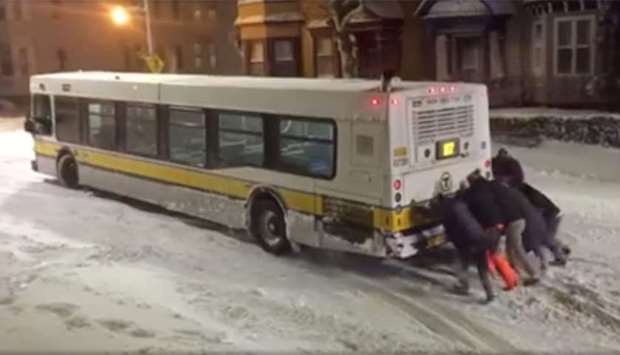Street crews dug out snow-clogged roads across the US Northeast on Friday after a powerful blizzard, as temperatures plunged during a brutal cold spell that has already killed at least 18 people.
Extreme cold will reach from New England to the Midwest and down to the Carolinas, forecasters warned. Temperatures were expected to be 20 to 30 degrees Fahrenheit below average across the northeastern United States for the next several days.
From Baltimore to Caribou, Maine, workers battled to clear snow and ice as wind chills were forecast to fall as low as minus 40 degrees Fahrenheit (minus 40 degrees Celsius) in some areas after sundown, according to the National Weather Service.
In the latest fatality blamed on the harsh conditions, a driver slid off an icy road, killing a pedestrian, early on Friday in North Charleston, South Carolina, city officials said. The 17-year-old driver was arrested on charges including going too fast for the conditions, they said.
‘THE DANGERS ARE REAL,’ the officials warned in a Twitter message. ‘Huge patches of ice all over the city. Stay at home.’
In much of New England on Friday, the highs reached only into the single digits or teens Fahrenheit, but wind chills made it feel below zero in many places.
‘It can be very dangerous,’ said Dan Pydynowski, a meteorologist with private forecasting service AccuWeather. ‘Any kind of exposed skin can freeze in a couple of minutes.’
There were noticeably fewer tourists on Friday afternoon in New York City's Times Square, which is usually thronged with visitors.
Arjun Shah, a 22-year-old Briton, studies in Indiana but had never visited the US East Coast. He flew in to New York City, where temperatures have been below freezing since Christmas Day, just 24 hours before the blizzard struck.
‘Oh it's so bad! It's not this bad in London,’ Shah said, shivering while taking a break from snapping photos of Times Square.
FROZEN MONUMENTS
In Washington, bundled-up tourists ventured onto the frozen Reflecting Pool in front of the Lincoln Memorial before being shooed away by a National Park Service ranger.
The memorial, also normally busy with visitors, was mostly vacant with temperatures in the teens and bone-chilling winds that sent American flags whipping straight out from their poles.
‘I don't think I've felt this cold, ever,’ said Zoie Irwin, a 19-year-old student from San Francisco State University as she huddled with friends.
At the nearby National World War II Memorial, Varun Solipuram, a 31-year-old native of Hyderabad, India, who studies in California, said he was taken aback by snow in the bright winter sun.
‘It's really beautiful,’ Solipuram said.
The storm that swept in on Thursday with gusts of more than 70 miles per hour (113 km per hour), dumped 22 inches (56 cms) of snow in parts of Maine and 17 inches (43 cm) in parts of Massachusetts, before ending on Friday, the National Weather Service said.
The storm was powered by a rapid drop in barometric pressure that some weather forecasters called a bombogenesis, or a ‘bomb cyclone.’
Cities from Houston to Boston have stepped up efforts to bring the homeless to shelters. Authorities said that three homeless people in Texas died from exposure to the cold.
Canada's largest city, Toronto, scrambled to find emergency shelter for the homeless as temperatures dropped to record lows after the sweeping storm knocked out power to tens of thousands in eastern provinces and destroyed coastal roads.
Numbing temperatures have also had some unusual effects: cold-shocked iguanas fell out of trees in Florida and wildlife officials in the state said they had rescued more than 200 stunned sea turtles from freezing waters.
Schools in New York were open, while children in Boston and Baltimore enjoyed a second day of canceled classes. Schools in Newark, New Jersey, opened two hours later than usual.
Commuters riding railways serving New York and Boston's suburbs endured extensive delays as crews worked to repair frozen equipment and clear snow-covered tracks.
New York's John F. Kennedy International and LaGuardia airports resumed flights on Friday after closing during whiteout conditions the day before. More than 1,500 flights at US East Coast airports had been canceled by Friday evening, most at the New York area's three major airports and Boston Logan International Airport.
Nearly 500 members of the National Guard were activated to assist with the emergency response along the East Coast, including 200 in New York state, authorities said.

